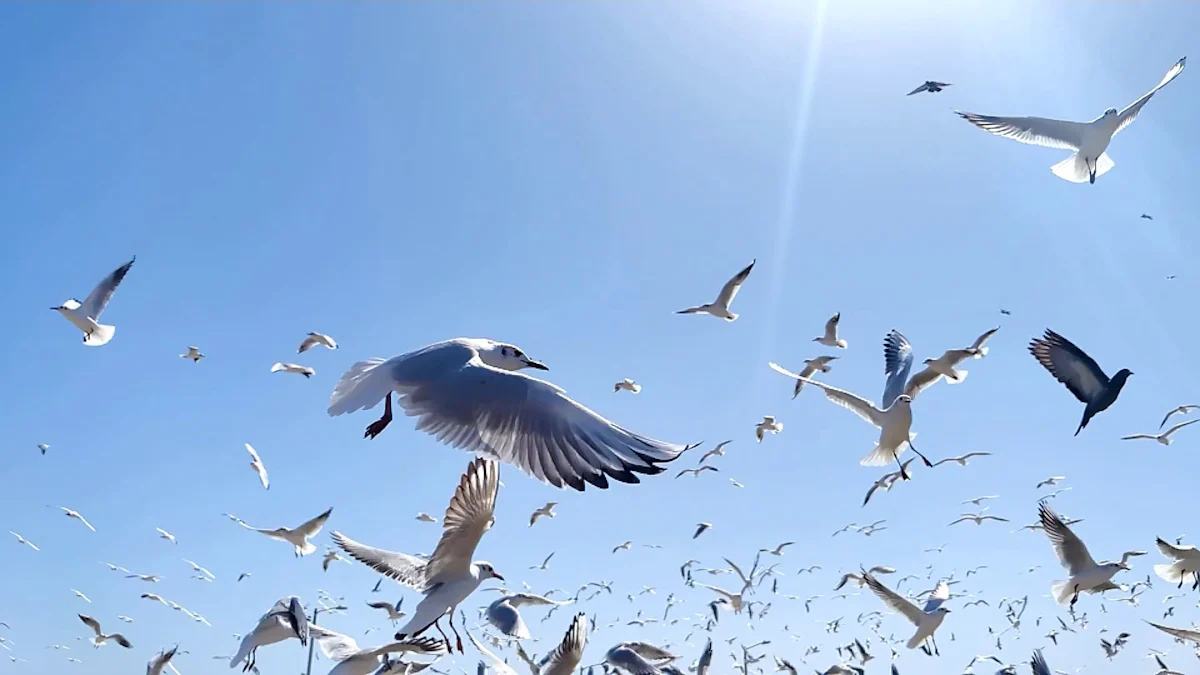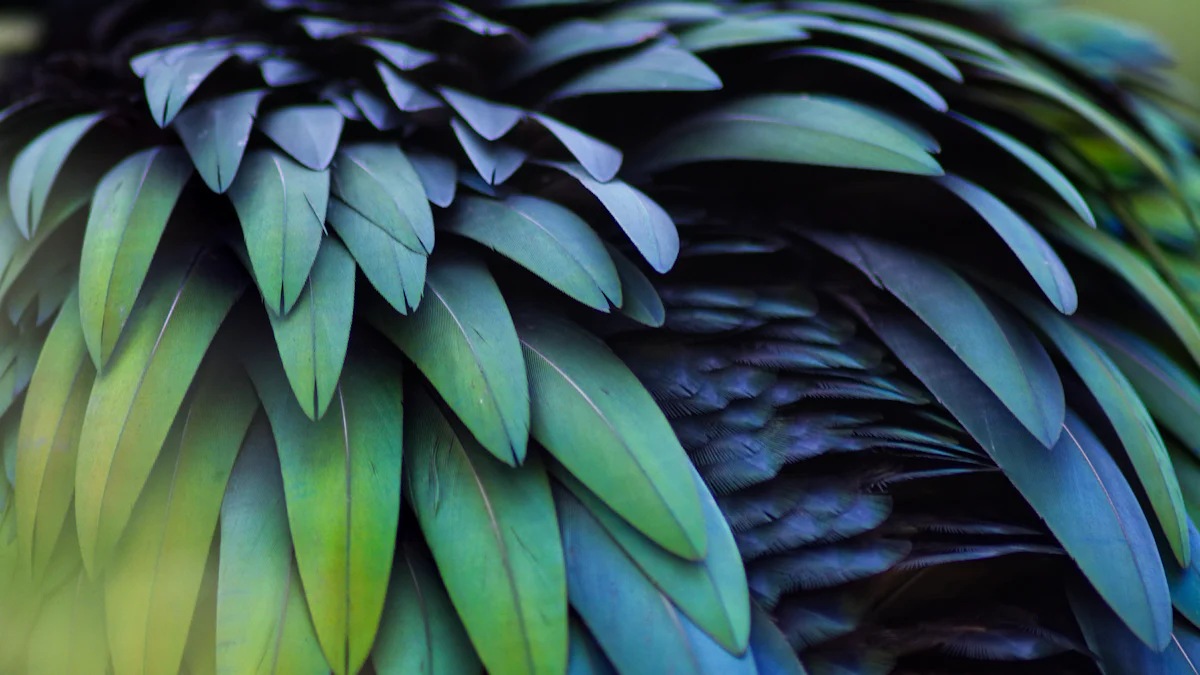
Bird flight captivates with its elegance and efficiency. Birds have mastered the skies for approximately 130 million years. Understanding how bird fly reveals the mechanics behind this natural wonder. Flight plays a crucial role in bird survival. Birds migrate vast distances, often beginning their journeys within a 69-minute window after dusk. This precision highlights the importance of flight in adaptation. Alaska's national parks showcase diverse bird species, each uniquely adapted to flight. Observing these creatures offers insights into nature's solutions for movement and survival.
Physical Features Enabling Flight

Anatomy of Bird Wings
Structure and Composition
Bird wings consist of feathers, bones, and muscles. Feathers provide the necessary surface area for flight. The arrangement of feathers allows birds to change wing shape. This morphing minimizes drag and maximizes thrust. Joints and muscles in the wings enable precise movements. These components work together to achieve efficient flight.
Wing Shapes and Their Functions
Birds possess wings with unique asymmetrical shapes. This design optimizes lift and control during flight. Different wing shapes serve various functions. Long, narrow wings suit soaring birds like albatrosses. Short, rounded wings benefit birds that require quick takeoffs, such as sparrows. Each wing shape reflects a bird's lifestyle and habitat needs.
Lightweight Skeleton
Hollow Bones
Birds have lightweight skeletons. Hollow bones reduce overall body weight. This adaptation aids in flight by decreasing energy expenditure. Despite being lightweight, these bones remain strong. The structure supports the demands of flight without compromising durability.
Adaptations for Reduced Weight
Birds exhibit several adaptations for reduced weight. Fused bones in the skeleton provide stability. This fusion reduces the number of bones, further lightening the body. Air sacs within the body enhance buoyancy. These adaptations contribute to a bird's ability to fly efficiently. Each feature plays a crucial role in maintaining balance and agility in the air.
Mechanics of Bird Flight

Understanding how bird fly involves exploring the principles of aerodynamics and the mechanics of wing movement. Birds have evolved to master these principles, allowing them to soar through the skies with grace and efficiency.
Principles of Aerodynamics
Lift and Drag
Birds generate lift by manipulating air pressure around their wings. The shape of a bird's wing creates a difference in airspeed above and below the wing. Faster air moves over the top, creating lower pressure. This pressure difference generates lift, allowing birds to rise into the air. Birds must also overcome drag, which acts against their forward motion. Streamlined bodies and smooth feathers help reduce drag, making flight more efficient.
Thrust and Propulsion
Birds achieve thrust by flapping their wings. The downward stroke pushes air backward, propelling the bird forward. Strong pectoral muscles power this motion, providing the necessary force for sustained flight. The wing's tip plays a crucial role in generating thrust. By adjusting wing angles and flapping frequency, birds control speed and direction. This ability allows birds to navigate complex environments with precision.
Wing Movement and Control
Flapping vs. Gliding
Flapping and gliding represent two primary modes of how bird fly. Flapping involves continuous wing movement, essential for takeoff and rapid maneuvers. Birds expend significant energy during flapping but gain immediate lift and thrust. Gliding, on the other hand, conserves energy. Birds spread their wings and use air currents to maintain altitude. This method is common among large birds like eagles and vultures. By alternating between flapping and gliding, birds optimize energy use during long flights.
Role of Tail Feathers
Tail feathers play a vital role in flight control. Birds use their tails to steer and stabilize during flight. Adjusting tail position helps birds change direction and maintain balance. Tail feathers also assist in braking during landing. By spreading their tails, birds increase drag, slowing down for a smooth descent. This precise control is essential for navigating tight spaces and avoiding obstacles.
Birds demonstrate remarkable adaptations in how bird fly, showcasing nature's ingenuity. The combination of aerodynamic principles and wing mechanics allows birds to conquer the skies with unparalleled skill.
Adaptations for Efficient Flight
Birds have evolved remarkable adaptations to achieve efficient flight. These adaptations ensure that birds can sustain long flights and navigate diverse environments with minimal energy expenditure.
Energy Sources and Metabolism
High Metabolic Rate
Birds possess a high metabolic rate, which fuels their demanding flight activities. This rapid metabolism allows birds to convert food into energy quickly. The energy supports the intense muscle activity required during flight. Birds need a constant supply of energy to maintain their high metabolic rate. This requirement explains why many birds consume large quantities of food relative to their body size.
Efficient Oxygen Use
Birds have developed efficient systems for oxygen use. Their respiratory systems include air sacs that enhance oxygen exchange. This adaptation ensures that birds receive a continuous supply of oxygen during flight. The efficient oxygen use supports sustained muscle activity. Birds can fly at high altitudes where oxygen levels are lower. This ability gives birds an advantage in various habitats.
Behavioral Adaptations
Migration Patterns
Birds exhibit fascinating migration patterns. Many species travel thousands of miles between breeding and wintering grounds. Migration allows birds to exploit seasonal resources. Birds time their migrations to coincide with food availability. This behavior ensures that birds have enough energy for the journey. Migration also helps birds avoid harsh weather conditions. Birds rely on environmental cues and internal compasses to navigate these long distances.
Flight Formations
Birds often fly in formations to conserve energy. V-shaped formations reduce air resistance for trailing birds. This arrangement allows birds to take turns leading the formation. Each bird benefits from the reduced drag created by the bird in front. Flight formations improve communication and coordination among flock members. Birds can respond quickly to changes in direction or speed. This behavior enhances the efficiency and safety of group travel.
Birds demonstrate incredible adaptations for efficient flight. These adaptations highlight the intricate balance of biology and behavior in how bird fly. Observing these adaptations provides valuable insights into the natural world.
Comparisons to Human-Engineered Flight
Similarities and Differences
Wing Design
Birds and airplanes both use wings to achieve flight. A bird's wing has an asymmetrical shape similar to an airplane's wing. Birds continuously change wing shape during flight. Airplanes have fixed-wing designs that remain constant. Birds generate lift and thrust by flapping their wings. Airplanes rely on engines for thrust and fixed wings for lift. Birds exhibit remarkable dexterity with minimal energy output. Airplanes require significant energy and infrastructure.
Energy Efficiency
Birds achieve high energy efficiency in flight. The wing design allows birds to glide and soar with little effort. Birds use natural air currents to conserve energy. Airplanes consume large amounts of fuel to maintain flight. Birds adapt to environmental conditions to optimize energy use. Airplanes follow predetermined flight paths with less flexibility.
Lessons from Nature
Innovations Inspired by Birds
Engineers study birds to improve aircraft design. Birds inspire innovations in wing flexibility and aerodynamics. Engineers develop morphing wings that mimic bird flight. These wings change shape for better control and efficiency. Birds influence the design of drones and small aircraft. Engineers aim to replicate the agility and energy efficiency of birds.
Future of Aviation Technology
The future of aviation technology looks to nature for inspiration. Engineers explore biomimicry to enhance aircraft performance. Birds provide insights into sustainable and efficient flight. The aviation industry seeks to reduce fuel consumption and emissions. Birds offer a model for achieving these goals. Observing birds can lead to breakthroughs in aviation technology.
Birds showcase incredible flight mechanics that inspire awe and wonder. You have explored the anatomy, aerodynamics, and adaptations that enable birds to fly. Observing birds in nature can deepen your understanding of these principles. Bird flight offers insights into reducing energy consumption and enhancing technology. Scientists learn from birds like hawks to develop energy-efficient designs. Understanding bird flight can improve conservation efforts and technological advancements. You can gain valuable knowledge by studying these natural aviators.
For more intriguing insights into birds and their mysteries, don’t forget to check out our blog!













